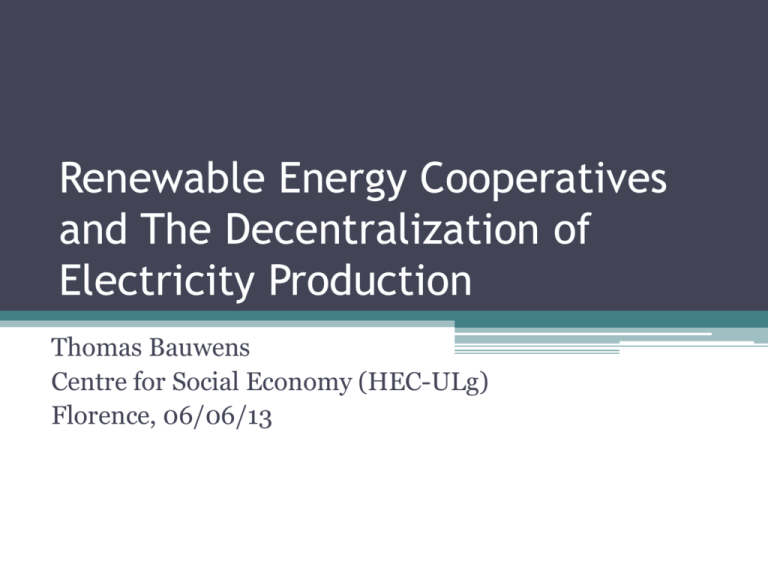Renewable Energy Cooperatives and Techno-institutional
advertisement

Renewable Energy Cooperatives and The Decentralization of Electricity Production Thomas Bauwens Centre for Social Economy (HEC-ULg) Florence, 06/06/13 Outline 1. The phenomena of path-dependence and lockin: application to the electricity sector 2. The roles of consumers in the electricity production 1.Path-dependence and lock-in • Introduction of dynamics in the alignment/coherence framework (Finger et al. 2010; Crettenand & Finger, 2013) ▫ Three configurations considered Public monopoly, including PPP Competition over existing networks Competition of networks ▫ Dynamics = shift from one configuration to another • But the transition from one configuration to another implies important costs, which arise from the inertia of past technological and institutional choices 1.Path-dependence and lock-in Path-dependence • current technologies and institutions depend on past technological and institutional choices Lock-in • technological systems and institutions follow a specific trajectory that is costly and difficult to change, due to the presence of increasing returns to adoption. • David and Arthur: technologies spread according to an autoenforcing process • Existence of increasing returns to adoption ▫ ▫ ▫ ▫ Economies of scale Network externalities Learning externalities Adaptive excpectations • Adaptation of this framework to social institutions (North, 1991) 1.Path-dependence and lock-in • The electricity sector as a socio-technical system ▫ system characterized by strong relationships between technological, institutional, economic and socio-political factors Socio-technical lock-in ▫ Combined interactions between those factors that mutually reinforce themselves to create inertia in the technological trajectories of our economies 1.Path-dependence and lock-in The socio-technical lockin in the electricity sector • Historically characterized by large centralized power stations • generally located close to sources of fossil fuels and remote from demand • which supply huge grids run by regional or national monopolies Distributed generation model • small generation units, typically ranging from less than a kW to tens of MW • geographically dispersed and located close to consumer sites • Higher involvement of consumers • Increasingly seen as a more sustainable model of power supply 1.Path-dependence and lock-in Organizational Industrial Institutional Technological Societal Sociotechnical lock-in in the electricity sector Behavioral Path-dependence and lock-in • In coherence with the alignment/coherence framework ▫ “There are innovative technologies that allow the production of electricity even at the level of private households… Also, ICT and power electronics allow for opportunities of dedicated electricity supply according to the needs and preferences of individual customers. If this technical development breaks through, a new technical paradigm will occur that would fundamentally change the technological practice of this sector. This would allow for a technical decomposition (i.e. fragmentation) of the electricity system. Obviously, this technological practice would fit much better to the institutional framework of a liberalised market” (Künneke, 2008) 2.The roles of consumers • Crettenand & Finger (2013): three main actors ▫ Institutional actors (political authorities, regulators, etc) ▫ Technological actors: have the possibility to innovate and develop technologies ▫ Market actors: provide the service of the given network industry • And… consumers! • The governance of infrastructures as common pool resources (Finger & Künneke, 2008) ▫ Place for Third Sector organizations in the governance regime • Concept of co-provision ▫ voluntary involvement of citizens in the provision and/or financing of publicly provided goods and services ▫ Network industries: services are usually provided by private firms that act within a framework of government regulation 2.The roles of consumers • “A new role for consumers—as energy suppliers in their own right—is one particular aspect of this potential step change. A pre-condition for this change is the diffusion of micro-generation technologies into the market which will depend on consumers’ acceptance of microgeneration technologies. The need for acceptance will in turn depend on the extent to which consumers are actively involved in the micro-generation deployment” (Sauter and Watson, 2007: 2771) • This involvement depends in part on the institutional arrangements of ownership and control of the production units Role for renewable energy cooperatives 2.The roles of consumers • By embedding technologies in social networks and fully involving consumers in the energy production, cooperatives could make the latter more willing to actively accept DG technologies • Enhanced public awareness and commitment regarding energy issues and energy technologies • Empirical aspects of social acceptance ▫ Attitudes towards such technologies ▫ Electricity consumption behaviors ▫ Investments in such technologies • Objective: empirical assessement of the enhancement of social acceptance





